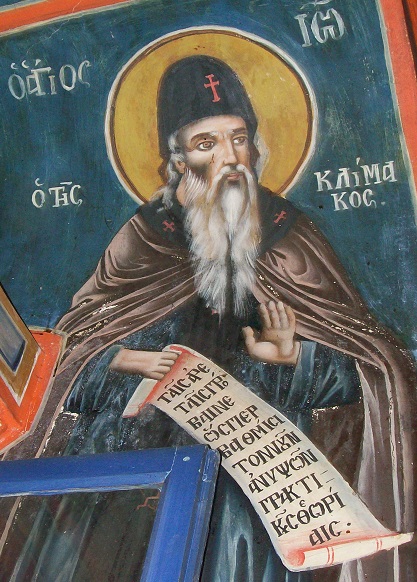St John of the Ladder – Part I
28 March 2017To Western eyes, the monk, increasingly, is a figure of yesterday, and the commonest images of him are of the kind to make easy the patronizing smile, the confidently dismissive gesture, or that special tolerance extended to the dotty and the eccentric. Around Friar Tuck, with his cheerful obesity, and Brother Francis, harming no-one as he talks to birds and animals, vaguer ghosts manage to cluster, gaunt, cowled, faintly sinister, eyes averted or looking heaven-wards, a skull clutched in a wasted hand, with gloom arising, and laughter dead.
Somewhere in the background there are bells and hymns, and psalms chanted well after midnight; and, as if to confirm that these are only the leftovers of a past surely and mercifully gone, there is the dumb presence of all those European monasteries visited for ten scheduled minutes during a guided tour, or else sought out on warmer evenings by courting couples.
But for Christians, that is, for someone who believes that there is a God, that God has manifested Himself in historical surroundings in the person of Christ, and that insights and obligations are thereby held up to everybody, the monk cannot easily be shrugged off…
A linguistic usage, so long employed by Christians that it has the look of being quite simply “natural” surrounds the individual monk with a wall of venerable words, a wall more solid and endurable than any that may set the boundaries of the area where he actually lives. For the talk is of “withdrawal” from “the world”, of “renunciation”, of a “monastic life” in contrast with the way other people happen to live, of being “apart from”, “away from” the rest of mankind, of pursuing a “dedicated” and “consecrated” path. And this language, with its emphasis on the difference between the monk and all others, very quickly begins to generate something more than a set of descriptions. It begins to imply a value system, a yardstick of achievement and worth until at last, and not surprisingly, there grows the irresistible urge to speak of a “higher”, “fuller”, and “more perfect” way of life…
Given those circumstances, it is reasonable to wonder how a Christian may now cope with the vast literature to which he is heir. It is also reasonable to anticipate that he will approach it with something less than automatic deference. And amid all the competing voices, his capacity to deploy a commitment and a sustained interest may well diminish as he strives to assemble for himself and for his friends criteria of evaluation that make some kind of accepted sense. How, for instance, is he to approach a work like The Ladder of Divine Ascent by John Climacus?
The setting at least can be readily established. The Ladder is a product of that great surge of monasticism which appeared first in Egypt during the third century, spread rapidly through all of Christendom, and eventually reached the West by way of the mediating zeal of figures such as John Casssian. The general history of this most influential development in the life of the early Church is well known, even if details and certain interpretations continue to preoccupy scholars, and there is no need to attempt here a sketch of what has been so well described by others…
That many of the first monks had glimpsed a connection between the experience of hardship and an enhanced spirituality is evident in the writings of the early Church. And in the neighborhood of that perceived connection were other sources of the resolve to enter on a monastic life. There was, for instance, the belief that, given the right conditions and preparation, a man may even in this life work his passage upward into the actual presence of God; and there, if God so chooses, he can receive a direct and intimate knowledge of the Divine Being. Such knowledge is not the automatic or the guaranteed conclusion of a process.
It is not like the logical outcome of a faultlessly constructed argument. There is no assurance that a man will come to it at the end of a long journey. But to many it was a prize and a prospect so glittering that all else looked puny by comparison; and, besides, there were tales told of some who, so it seemed, had actually been granted that supreme gift of a rendezvous…
There is now in the consciousness of the West a terminology and set of value judgments centered on the person. From the era of the Renaissance and the Reformation up to the present time, there has been a steady progress in the insistence on the reality and the inherent worth of the individual. Some philosophers, of course, would argue that man the word-spinner has in this merely demonstrated once again his capacity to sublimate reality and has only succeeded in hiding from himself that he is no more – and no less- than a very complex organism.
But this is not a widely shared view. Instead, there is much talk of human rights, of one man’s being as good as another, of the right of the poor to share in the goods of the world, of one-man-one-vote. What all this has done to a belief in God is a theme of major import. However, on a more restricted plane, a difficulty for anyone today reading The Ladder of Divine Ascent or similar texts is that in these a somewhat different view of the person is at work. If modern Christianity has invested heavily in the notion of the value of the individual person, it has been at the cost of a seeming incompatibility with much that was felt and believed in the early Church.
[To Be Continued]






